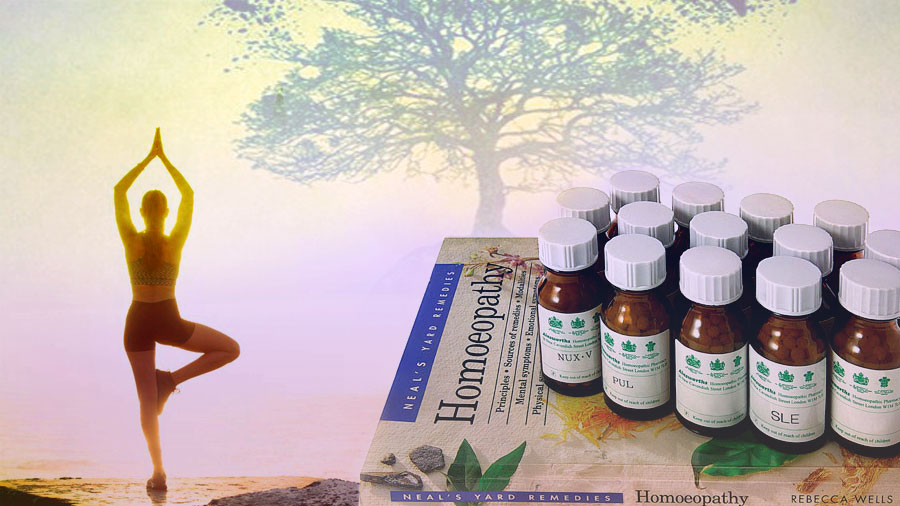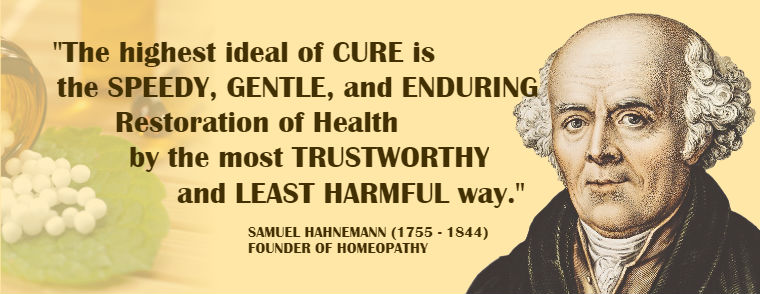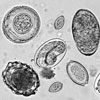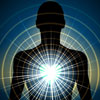The Homeopath’s View Of Health And Disease
 by Dr. Peter Glidden, ND
by Dr. Peter Glidden, ND
Homeopathy is just one type of Wholistic medicine. It has its own unique way to work with the Wisdom of the body, and its own unique medicines which it uses in the treatment of disease. Here is a little window into the mind of a homeopath.
To a homeopath, the symptoms of a disease are everything. They are the alpha and the omega. They are the gold ring that the homeopath tries to grasp when sitting in the presence of the sick and unhealthy. Acute and detailed awareness of symptoms is completely indispensable to the discovery of a curative medicine with homeopathy. If a homeopath does not have a good understanding of the symptoms of the sick person, he will not be able to come up with an effective treatment. Interestingly, to the homeopath, the symptoms of the sick person are represented in ways that most people (and all allopaths) would find curious. I was walking down the street one day with a friend of mine who is an architect. I remarked that the town we were in was a little boring because the Historic District Commission had implemented rules that restrained how many colors you could paint a house, and even what type of materials could be used on the outside of it. Well, I might as well have said that the Pope was a Protestant, because he sat me down and proceeded to give me a detailed schooling in the intricacies of the local architecture that I had completely overlooked. We were both looking at the same scenery, but where I saw homogeneity, he saw detail and uniqueness. This house had copper gutters, that one had a whale-tale door knocker made of brass, that one had a circular window over the door, and the one next to it had an upside-down horseshoe masoned into the brick work of its chimney, etc., etc.. This “attention to detail” is what a homeopath uses to analyze someone who is sick. The homeopath is able to pull out details of the symptomology which a normal person would completely overlook.
As an example, let’s say that a person is suffering from migraine headaches. They go to their MD for help. The office visit lasts 10 minutes, and after listening to a brief description by the patient of what is going on, the MD comes up with a diagnosis of “Migraine headaches,” and a generic medication (usually Fiorinol®) is given. If that MD saw 100 migraine patients that week, they would all get Fiorinol®. The patient takes the drug, and it helps to manage the pain, but in a few days the pain comes back, and a stronger strength Fiorinol® is given. This continues for 6 months, with the Fiorinol® helping to shorten the intensity and duration of the attacks, but every few weeks, its dosage has to be increased, and the migraines keep on coming. The patient is eventually put on 3 different drugs over the course of 3 years, to try and manage the pain, and nothing gets cured, the migraines keep coming.
Eventually, the migraine sufferer gets fed up with the ineffective drug treatments and goes to his friendly neighborhood homeopath for help. The office visit lasts 1.5 hours. The homeopath takes an indepth symptom inventory by asking the patient detail-oriented questions about the headache. Questions like: Where anatomically do you feel the pain? Is it in the front of the head, the sides, or the back? Does it hurt on one side more than the other? What does it feel like? Does the pain stay in one spot, or does it shift around? When does the pain occur? How long does it last? Is there a predictable pattern to the onset of the attacks? What makes the pain feel better? What makes the pain feel worse? Are there any other physical, mental or emotional symptoms that accompany the head pain? Does anything repeatable or predictable happen right before or right after an attack? Historically, what was going on in your life when the very first attack occurred? Are there any other physical, mental or emotional complaints that have bothered you in a chronic fashion over the course of your life?
The homeopath is not asking these questions to placate the patient nor to engender the patient’s trust. He is asking them because, to the homeopath, the way that the body expresses its symptoms holds the key to determining the cure. When Sherlock Holmes examined a crime scene, all of the minute details were important to him and came into play. Just as sometimes it was the cigarette ash under the kitchen table that held the key to solving the crime for Holmes, sometimes it is a strange, rare or peculiar symptom expressed by the patient that holds the key to the cure for the homeopath. Here is an example of what a migraine sufferer may disclose from the promptings of a competent homeopath:
“Doc, I get these sharp stabbing pains over my left eye. The attacks happen about once every 2 weeks, but if I am really worried about something, or somebody, they can happen then too. They can last all day. Sometimes the pains feel like they go backwards into my brain, but mostly I just feel them over my left eye. The skin of my face around my left eye gets really sensitive during the attacks, and I don’t want anything or anyone to touch me there. Sometimes the pain feels better if I put a cold towel on my forehead. But I don’t like to do this, because when I take the towel off, the pain always gets worse. Often I will get dizzy right before the pain happens, and the dizziness is made 10 times worse if I look down at the ground. If I lie on my left side the pain gets much worse also, so I hope it doesn’t happen at night because I sleep best when I am lying on my left hand side. The only other thing that helps me to deal with the pain is if I lie perfectly still. The pains started 4 years ago about 1 month after my mom was diagnosed with cancer – I worry about her too much, I know – but I can’t help it.”
Now – when did you EVER have a conversation with your doctor that went something like that? Did I hear you say “never?” Well, that’s par for the course in the backwards land of allopathic reductionism. It’s too bad really. These conversations happen every day in my office, and in the office of every good homeopath around the world. As homeopaths, we have been trained to listen closely to the symptomatic language of the body, as it holds the key to the cure. Why does it hold the key to the cure?
This is where homeopathic philosophy gets really interesting, and even borders on the mystical. A homeopath pays attention to the symptoms of the sick person because he is trying to find a medicine which produces exactly the same symptoms as when it is given to a healthy individual. The migraine sufferer above would be given the medicine “Spigelia anthelmia” because, when healthy people take it, they get exactly the same pains that this migraine sufferer was experiencing. I have italicized the word “exactly” in the last 2 sentences for a reason. In order for the Law of Similars to work, the medicine delivered to the sick person must match their subjective symptoms exactly. This is the problem with homeopathy. If the homeopath does not hit the bulls-eye with the prescription, nothing of value will happen to the disease state. The Law of Similars is a harsh mistress, and demands 100% accuracy with each prescription. If another patient was suffering from migraines, but his pain was over the right eye, and felt worse from lying still, Spigelia would not afford him a cure! This is why, to the homeopath, the concept of generic dosing for a disease is childish and absurd. Everybody is unique, and the symptoms of their diseases are also unique. There is no “one size fits all” homeopathic medicine for anything.
This concept of paying attention to the language of symptoms also brings to light an interesting distinction between allopathic and Wholistic medicine (in this case, homeopathy).
Allopaths have been trained to treat the disease. So everybody with the same diagnosis gets the same drug.
Homeopaths have been trained to treat the person. So everybody gets the medicine most suitable for their own unique set of symptoms. Ostensibly, a homeopath could be treating triplets for pneumonia, and even though they have the same genes, and were exposed to the same bacterial stress, they will need 3 different medicines in order to get better because they have 3 completely different sets of pneumonia symptoms.
Let’s take this concept one step further. From the unique perspective of the homeopath, there is no such thing as “pneumonia,” or “asthma,” or any other disease for that matter! Think I am wrong? OK – please bring me some pneumonia. Can’t do it? Well, what about a pen? Can you bring me a pen? You can?! Why thank you! What about arthritis? Please bring me a box full of arthritis. What’s that you say? You can’t do it? Exactly! You can’t do it because diagnostic names are merely that – they are names only, and as such they are all intangible. A pen, on the other hand, is a tangible object. A diagnostic name is only a description of the general state of a disease process. It does not exist in the real, physical world as a tangible object. Somehow, the close-minded allopath has chosen to turn a blind eye to the individualizing details of the symptomology of the sick, and focuses instead, on its gross generalities. This is like referring to a Chihuahua, a Great Dane, and a mutt that is ½ Cocker Spaniel and ½ Golden Retriever all as ‘dogs.” Well, er- yes, they are in fact, all dogs, but they are at the same time EXTREMELY different, each from the other, and you would think that those distinctions would be important. Well, they are – but not to the allopath.
To the Wholistic physician, the distinctions in the symptomology of the disease are everything. We can say that there are types of pneumonia, types of arthritis, etc. But this is as far as we are willing to take it. Terminology has its place, of course, and Wholistic physicians understand that if somebody has a definitive diagnosis of pneumonia (for example) then there are certain indications that we can expect to see in their blood work and on their physical exam, and we also know that there are certain predictable signs as to the different stages of pneumonia in general that we need to be on the look-out for. But our treatments are not designed to treat pneumonia, because pneumonia is an intangible description only. The Wholistic (homeopathic) treatment is designed to treat the person who is suffering from the thing that we are calling pneumonia. Ten different people, all with pneumonia, would need ten different treatments from a homeopath – so how is it possible for them to all have the same thing? They don’t! They all are suffering from different manifestations of a disease process which is generally referred to as pneumonia.
Well, “Great!” you may think, but just how does it work? I mean, how does the Law of Similars bring about healing? Good question! The answer is: “I don’t know.” Nobody knows why or how the Law of Similars works. We only know that it works – its mechanism is unclear. In this regard, it is like gravity. Scientists can measure the effects of gravity, and know what to expect when it is present, but they have no idea of what causes it. Not even Einstein could figure it out. So it is with the Law of Similars. We can see it work, and predict with accuracy what will happen when it is activated, but the mechanism by which it works is unclear. There is, however, an interesting analogue to the Law of Similars in the world of physics that is interesting to talk about. When scientists study how waves (water waves, sound waves, radio waves, etc.) affect each other, they notice an interesting phenomenon. When 2 wave forms of exactly the same wavelength and frequency run into each other, they cancel each other out completely. This is the science that noise canceling headphones are based on.
I remember a physics experiment from my high school days. The teacher took a rectangular waterproof tank that had Plexiglas on the bottom so you could see through it. He put about an inch of water into it and then put it on the overhead projector so the image of the water could be magnified and projected onto the wall. Then he dropped 2 fishing sinkers that were the same weight into opposite ends of the tank (from equal heights). When the weights hit the water, they created waves that were exactly the same (the same wave-length, wave height, and frequency). As the 2 sets of waves rushed toward each other from opposite ends of the tank, they caused lots of turbulence in the water. But where they finally intersected each other in the middle of the tank, the water was COMPLETELY calm. Not a ripple! This was not happenstance, and the teacher wasn’t a magician. The experiment was meant to demonstrate the particular law of physics which states: “When 2 identical wave forms intersect, they will cancel each other out.” It is theorized that the Law of Similars works the same way. But nobody knows for sure.
What we do know for sure is that when we deliver a medicine to a sick person that caused in a healthy person the exact same set of symptoms, the sick person’s illness disappears – every time. Here’s an example. It is excerpted from the book: Testimony of the Clinic, by E.B. Nash, a prominent 19th century homeopath. I include it here for 2 reasons: 1) a taste of the grand history of homeopathy, 2) because it is an excellent example of the power of the Law of Similars, correctly activated.
A boy of thirteen, becoming overheated while roller skating sat down on a curb stone to cool off. A severe cold resulted with general aching; next rheumatism of knees and ankles developed; worse on motion. Next day it had left the legs and attacked the shoulders and arms. From that point it flew back to the feet, which began to swell. He had received Bryonia, Lachnanthes, Ledum, etc., (e.g. 3 homeopathic medicines) according to the symptoms; but at this point I was confined myself to my home for some days, and had to rely upon the reports of his parents, which were vague and indefinite. They now reported that while the feet continued to swell, the rheumatism was gone, but that now he had pain in his chest; it hurt him to breathe, was impossible for him to take a long breath. I gave Bryonia, then Cimicifuga (e.g. 2 homeopathic medicines) upon their representation, without good result; the boy grew worse. On the sixth day the mother reported that the boy was so weak that he could scarcely speak. I cross-questioned her very closely. Among other things asked, lying upon which side was the pain worse? ‘O,’ exclaimed the poor woman, ‘I forgot to tell you, he can’t lie down at all. He hasn’t lain down for five nights. We have him in a Morris chair. He sits bent forward all night with his head resting in a chin strap made of towels.’ A light broke upon me. Then I knew it was no pleurisy I had to deal with, but rheumatism of the heart.
I hastened to his home. As I entered the room I was shocked at the pitiful change in the child since I had seen him six days before. The labored gasps for breath could be heard outside the door, the little figure sat bent forward in the Morris chair, face blue, cyanotic, swollen, feet and ankles swollen as big as watermelons; but the thing that struck me most as I entered was the terrific visible throbbing of the carotids (e.g. the arteries in the neck that you feel when checking for the heartbeat), which could be seen across the room. It was with great difficulty that I could examine his heart; he could not endure the least touch, and at each attempt he gasped, ‘O, doctor, give me a little more time.’ I finally made out a muffled, tumultuous heart sound, as if beating under water. The temperature was 103°, yet there was a great deal of perspiration, urine very scant, no thirst, no appetite. He had only slept short naps for many nights. I feared the boy was dying. There was a time when I would have treated the heart symptoms with Aconite or Kalmia, and the dropsy with Apocyanum, (e.g. 3 homeopathic medicines) and what not, and so zigzagged to a slow cure or a speedy death. But fortunately I knew better now. I knew that every one of these symptoms are summed up under one remedy, and covers every point exactly. I gave Aurum 10x one dose to be given every three hours. (e.g. In this case, “Aurum” was the bulls-eye remedy – finally discovered. It is made from a homeopathic preparation of the element Gold! ‘10x’ denotes the strength of the medicine.) I never saw a more brilliant cure. The first dose was 7 P.M. I requested that they phone me at 11 P.M.
That night at 11 P.M. the message came, ‘Louis is in a drenching perspiration, he has urinated quantities, and his breathing is less labored.’ At 8 o’clock the next morning they phoned that he had slept peacefully most of the night though still in his upright position with chin-strap. That night he could recline in the chair, and the next he could lie down in bed. The urine continued in unbelievable quantities, the perspiration rained from him, and the swelling promptly disappeared. You see what a profound element gold is when homeopathically indicated. The lad made a rapid and complete recovery with no other medication. He received it first in the 10x, then I rose it to the 30th, then to 200th, (e.g. these are all different strengths of the same medicine) on which I kept him until the poor damaged little heart was quite normal again.
You will recall that every one of the above symptoms are recorded by Hering and Hahnemann in these words (e.g. These are none other than Constantine Hering, and the discoverer of homeopathy himself, Samuel Hahnemann. Nash is referring here to books written by these 2 men. Books which outlined the symptoms produced by homeopathic medicines. Books like these are referred to as “Materia Medicas.” Following are some of the symptoms produced by homeopathic Aurum, as recorded by Hering and Hahnemann): ‘Rheumatism which jumps from joint to joint, finally fastens upon the heart. Impossible to lie down. Must sit up bent forward.’ ‘Visible throbbing of carotids.’ ‘Face cyanotic, gasps for breath, can hardly speak above a whisper.’ ‘Much perspiration, as in auric fever.’ ‘Swelling of feet and limbs.’ Does that not picture the little boy just described?…(Now one of Nash’s colleagues, named Rauterberg, replies): “I should say it does, and feel free to add that it is one of the best cures in homoeopathic literature. No routinist or pathological hobby rider would have ever thought of that remedy.”
This was a nice case because it shows quite clearly the homeopathic necessity of prescribing exactly the right medicine for each patient, and also how the selection of the correct medicine can turn on a dime. If Nash hadn’t known about the boy’s inability to lie down, nor seen his pounding carotid arteries, he wouldn’t have selected Aurum as the medicine, and the child would not have recovered. Furthermore, all of the lab work and diagnostic discovery in the world would not have helped him one bit to discover the curative treatment. What was required was the acute observation of the subjective symptoms of the disease. This is really quite a profound statement when you think about it. As modern medicine hurtles down the road of MRIs, CT scans and sophisticated blood analysis, they get further and further away from being able to see and understand the most important symptoms of all – the subjective ones – and with that further and further from the cure.
 The “Law of Similars” was discovered by a German physician in the 19th century. His name was Samuel Frederick Christian Hahnemann. He was the discoverer and original architect of Homeopathic medicine. He developed the homeopathic medical system after observing that Malaria patients who were given large amounts of the drug Quinine, developed (as side effects of the quinine), the exact same symptoms as people suffering from Cholera. Hahnemann gave Cholera patients quinine, and they experienced rapid and permanent cures of their Cholera! This was a tremendous medical breakthrough, and opened a new door into the nature of illness and the treatment thereof.
The “Law of Similars” was discovered by a German physician in the 19th century. His name was Samuel Frederick Christian Hahnemann. He was the discoverer and original architect of Homeopathic medicine. He developed the homeopathic medical system after observing that Malaria patients who were given large amounts of the drug Quinine, developed (as side effects of the quinine), the exact same symptoms as people suffering from Cholera. Hahnemann gave Cholera patients quinine, and they experienced rapid and permanent cures of their Cholera! This was a tremendous medical breakthrough, and opened a new door into the nature of illness and the treatment thereof.
Do you not think it is just a little peculiar that nature has developed different substances (plants, and the elements (like gold)) that give to homeopaths the perfect instruments to activate the Law of Similars? What are the chances of something like this happening randomly – again and again? In Nash’s patient above – the boy’s rheumatic heart disease symptoms were perfectly matched by a homeopathic preparation of the element gold. This means – you dig some gold up out of the ground, you prepare it homeopathically, you give it to a group of healthy people and you record the symptoms they develop. The symptoms they develop are an exact match of the symptoms that occur when some people become afflicted with rheumatic heart disease! What! What’s going on here?
If Life, the Universe, and Everything are just random collections of chemicals, as the allopaths assume, then the chances that naturally occurring substances would be able to cure diseases should be just this side of impossible. But they do – again and again and again. For instance, the element Phosphorous produces many of the symptoms of bronchitis and pneumonia. Digitalis purpurea (a plant with the common name “Foxglove”), when prepared homeopathically, gives us many of the symptoms of heart failure and depression. Homeopathic poison ivy is a fantastic medicine for certain types of anxiety and arthritis! The list goes on and on. We find in nature, over and over and over again, the perfect raw materials from which to generate medicines to cure the sick. Perhaps, as humans, our relationship to the Earth is a little more dynamic than we have previously thought. This phenomenon of the unusual healing capacity of naturally occurring substances is one of the greatest arguments for saving as many plant and animal species as we can. It is entirely possible that a plant species able to cure certain manifestations of the AIDS epidemic, or certain types of cancer has just been burned to extinction somewhere in the Amazon!
Our troubled cousins, the allopathic MDs, are not even aware that the Law of Similars exists, or if they are, they discount it as quackery because they were not taught this in medical school. This is one of the most hypocritical and disappointing things about allopaths. On the one hand they claim to be the high priests of science. For them its double blind this, and double blind that, and don’t use a treatment if it hasn’t passed muster by being published in a peer-reviewed medical journal. Blah, blah, blah. But when it comes to one of the greatest medical discoveries of the last 200 years – The Law of Similars – they dismiss it out of hand, without examining it scientifically at all. You would think that some place like the Harvard Medical School would have examined this phenomenon seriously. They have not. These intellectually stilted people are no better than the “scientists” of Galileo’s time who had him imprisoned for postulating the ‘ridiculous’ notion that the Sun, and not the Earth was at the center of the solar system.
Excerpt from The MD Emperor Has No Clothes
Posted in Health, Other Topicswith comments disabled.





